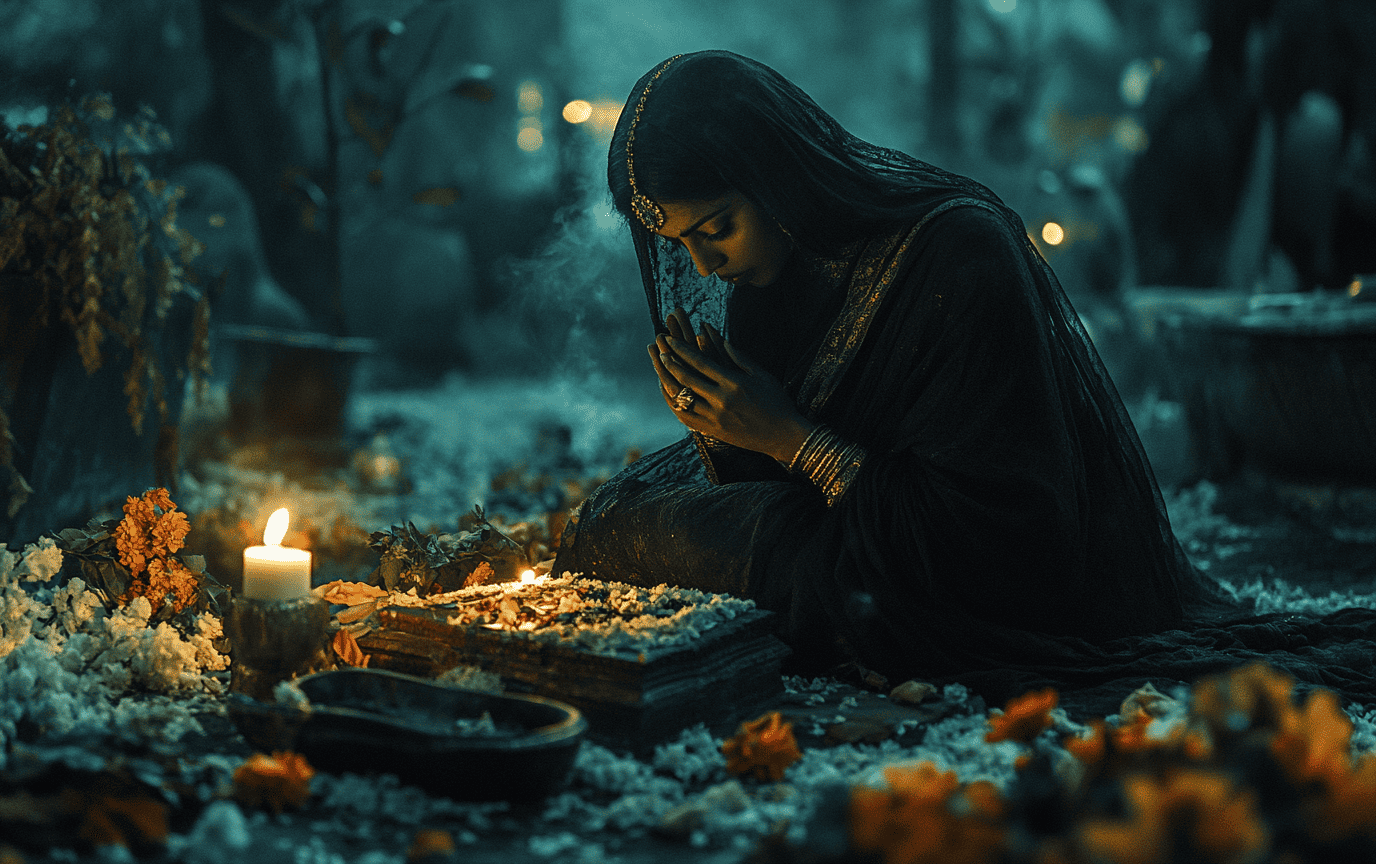Death and mourning—the two companions we all encounter on this journey we call life. They weave their way through our existence, with each culture creating its own unique fabric of funeral rites, mourning customs, and afterlife beliefs. Traveling to far-off lands opens our eyes to the ways people remember their loved ones and facilitate their passage into the great unknown.
So grab a cup of your favorite brew, settle into your comfy chair, and let’s journey through the intricate world of death rituals and the spiritual responses they elicit. You might find the practices of others echoing in your own heart.
1. Latino Traditions
Ah, the warmth of a community that embraces the bittersweet symphony of life and death! In Latino cultures, especially where Catholicism holds its ground, the spirit of togetherness shines brightly. The dying often find solace in their homes surrounded by the unwavering love of family.
Picture this: a dimly lit room, filled with the soft whispers of prayer, and the scent of candied bread and rich spices wafting through the air. Funerals in these cultures don’t just focus on the somber; they are celebratory as much as they are mournful. After the funeral mass, families flock to the graveside. Picture the priest gently blessing the earth, followed by a procession that feels more like a gathering of loved ones than a farewell party. And then there are novenas—prayers whispered over nine days post-burial, where one seeks solace in community and faith.
But perhaps the most vivid example is the Día de los Muertos (Day of the Dead) in Mexico. This day opens doors to the past; families create stunning altars stacked high with marigolds, sugar skulls, and the favorite dishes of their departed. It’s a night when laughter and tears draw close, demonstrating that death is merely a doorway, not an end.
2. African American Practices
Life, death, and everything in between play to a rhythm forged in the heart of collective memory. African American mourning traditions mix African, European, and American influences, creating a rich tapestry of practices that resound with vibrancy and community spirit. Funerals here aren’t just proceedings; they’re electric celebrations of life!
Imagine stepping into a room that feels more like a reunion than a goodbye. Laughter and music permeate the air as a family embraces the circle of life—food is shared, prayers are lifted, and feelings run wild. The wake is crucial, serving as a sanctuary where the community gathers for support and fellowship. It’s a beautiful tapestry of shared sorrow and joyous remembrance.
In New Orleans, enveloped in the notes of jazz, the “jazz funeral” takes shape—a melodic march celebrating the deceased into the afterlife. As mourners sway in rhythm, this soulful farewell reminds us that while death may part us physically, the spirit of our loved ones dances eternally by our side.
3. Jamaican Funerals
In Jamaica, death is a thread woven into the fabric of existence. Funerals can be delayed, allowing family members from afar to make the journey and pay their respects. As the day unfolds, emotions spill forth freely. Wailing—a guttural expression of pain—echoes through the air as we dance between joy and sorrow.
Then comes the Nine Nights tradition, born from the soul of Africa and steeped in the legacy of slavery. Picture a gathering where laughter, tears, and reminiscences intermingle over a week-long celebration. This beautiful custom allows the spirit, or duppy, to find comfort and peace over nine nights of collective grief and memory.
It’s not just a tradition; it becomes a rite of passage for both the living and the dead, as friends and family band together to share stories and songs, creating a powerful energy that wraps around everyone like a warm blanket.
4. Jewish Traditions
In Jewish culture, the exchange of grief resonates deeply, echoing through the very essence of their beliefs. Typically, burial occurs swiftly—within 24 hours of death—reflecting a profound respect for the body, seen as a vessel created in God’s image. It’s as if time stands still, beckoning us to honor the passage from life to what lies beyond.
Following the burial, mourners enter the Shiva period—seven days steeped in tradition, filled with prayer and communal support. The home transforms into a sanctuary where friends and family unite. Every visitor who walks through that door adds another stitch to the fabric of grieving, reminding the mourners that they are not alone.
During this time, the Kaddish is recited—a beautiful prayer that honors the deceased while simultaneously affirming the Presence of the Divine. In each word, mourners weave their love into memories, etching their stories in both the hearts of those present and the heavens above.
5. Hindu Practices
Hinduism offers a lens of spirituality and profound respect for the cycle of life and death. The journey often leads to cremation, where sacred chants rise with the smoke as the physical body is transformed. Picture the smell of sandalwood as the fire dances, enveloping the deceased with warmth and grace.
The mourning period stretches long, often lasting up to 90 days, a time for family to reflect and heal. Dressed in white, the mourners stand together, united by grief and tradition. There’s a palpable sense of support as they carry sticks symbolizing strength, a reminder that sorrow can be shouldered together.
But it’s within the rituals of ancestor worship where we see the true essence of remembrance. Offerings of food and flowers sustain the bond with those who have passed on, a heartfelt connection transcending the limitations of time and space.
6. Chinese Ancestor Worship
In Chinese culture, death is not an ending but rather a continuation of a bond that runs deep. Ancestor worship is a practice layered in respect and memory. Families gather during festivals like the Qingming Festival, a day dedicated to honoring the spirits of those who came before. The air is thick with the scent of burning incense, food is laid out as offerings, and paper money is set ablaze—symbols of love and connection that reach beyond this life.
These acts ensure that ancestors receive the sustenance they need in the afterlife and, in return, bestow blessings upon the living. It’s a relationship built on honoring, sharing, and maintaining that beautiful link to the past.
7. Western Perspectives
In Western societies, particularly in the U.S. and Northern Europe, death has traditionally bore the weight of solemnity. Yet, in recent years, a subtle metamorphosis has unfolded. Once characterized by mournful gatherings, contemporary views invite a more personalized expression of grief—one that reflects individuality and deeper emotional understanding.
We are witnessing the emergence of new rituals, ones that honor the complexities of life and loss. Personal mementos adorn spaces, and heartfelt tributes are crafted to symbolize love and remembrance. There’s a growing desire to shed the veil of restrictions surrounding mourning and to embrace the beauty of memories in a more authentic way.
Conclusion: A Mosaic of Grief and Memory
As we traverse this diverse landscape of death and mourning rituals, we discover a spectrum of expressions that enrich our understanding of loss. Each culture’s traditions serve as a mirror reflecting their values, beliefs, and love, creating a legacy of remembrance that stands timeless. From the vibrant Día de los Muertos to the subdued Shiva, each memorial invites us to appreciate the shared human experience of grief.
Ultimately, these customs remind us of the beauty of community and connection, where death transforms into a celebration of life, legacy, and continuity. They invite us not to shy away from the inevitable but to embrace it fully, finding solace in love and memory across borders and beliefs.
Whether we’re visiting foreign lands or reflecting on our own practices, we carry threads of these rituals within us. They unite us in a common thread, a tapestry of collective experience—a beautiful reminder that we each contribute to the memory of love.
Want to stay updated on the latest travel tips? Check out our Travel Tips section: Travel Tips! Looking for lifestyle inspiration? Explore our Lifestyle category! Discover amazing destinations at Destinations. Join our journey on YouTube: YouTube, or follow our adventures on Instagram and Pinterest!
Travel well, friends, and may your journeys be filled with curiosity, connection, and beautiful memories.













